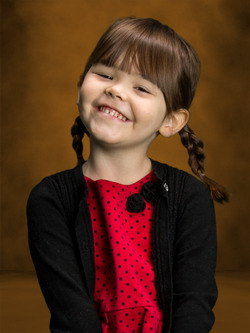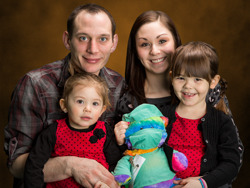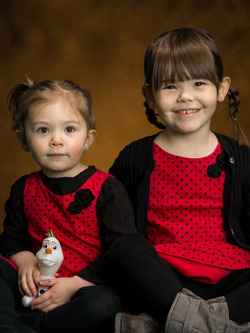Miracle Kid: Peyton Bean
4-Year-Old Saved After Car Accident, Craniofacial Surgery
 Your daughter was in a car accident. She’s being airlifted to Strong Memorial Hospital in Rochester.
Your daughter was in a car accident. She’s being airlifted to Strong Memorial Hospital in Rochester.
For the longest 90 minutes of their lives, that’s all Taylor and Robert Decker knew for sure.
As they made the drive from Syracuse to Rochester, they tried desperately to learn more about what had happened to their little Peyton. But mostly, they were alone with their thoughts and fears.
Airlifted?
Eventually, they got an EMT on the phone.
He didn’t know much, but he’d been at the scene of the crash, and said that Peyton had been crying when she was removed from the wreckage.
Crying. That’s a good sign.
They clung to the hope as they neared the hospital.
When the Deckers reached the intensive care unit at UR Medicine’s Golisano Children’s Hospital, they were ushered to their 4-year-old’s bedside. Her face was bloodied and bandaged, and a dozen doctors and nurses were hovering around her.
Now, the information started coming much faster.
The car had spun off the highway and hit a tree. The driver, a relative, had only minor injuries, but Peyton’s head and face had taken the brunt of the impact.
 Her skull was fractured. Her jaw was shattered, and her upper palate was split down the center. Her right orbital bone was fractured in multiple places. And the broken bones had punctured her dura — the outermost layer of the brain — causing cerebral fluid to leak.
Her skull was fractured. Her jaw was shattered, and her upper palate was split down the center. Her right orbital bone was fractured in multiple places. And the broken bones had punctured her dura — the outermost layer of the brain — causing cerebral fluid to leak.
No one could say whether she would survive.
“She had so much swelling that they couldn’t go in and do any surgery at first,” said Taylor Decker.
She also had a broken leg, and for three days, the Pediatric Intensive Care Unit team, led by Walter Pegoli, M.D., worked to keep her stable while her swelling came down. Finally, the Deckers were told that Peyton was going to live.
But serious questions remained.
“They said it was possible she had neurological damage, possible she would be blind, or that she wouldn’t be able to hear,” said Taylor Decker.
Five days removed from the accident, the swelling had gone down far enough for the surgical team to begin preparations to repair the broken bones in Peyton’s face.
Clinton Morrison, M.D., director of the Pediatric Cleft and Craniofacial Anomalies Center, explained to the Deckers all of the surgical fixes that he needed to make.
“We met him and he started going over everything — I want to say he was with us for two-three hours,” said Robert Decker. “We could tell that he wasn’t going to leave until he was comfortable that we were comfortable. He probably re-answered questions five or six times and didn’t bat an eye. He was spectacular.”
 Before the surgery began, Morrison studied photos of Peyton, in the hopes of rebuilding her bone structure as precisely as possible. Her jaw and palate were major concerns, having broken in a way that the surgical team had never seen before. But Morrison worked closely with Joseph J. Fantuzzo, D.D.S., M.D., to ensure that the team would be able to rebuild it as accurately as possible, and together, they designed a splint that would help hold Peyton’s bones together as they healed.
Before the surgery began, Morrison studied photos of Peyton, in the hopes of rebuilding her bone structure as precisely as possible. Her jaw and palate were major concerns, having broken in a way that the surgical team had never seen before. But Morrison worked closely with Joseph J. Fantuzzo, D.D.S., M.D., to ensure that the team would be able to rebuild it as accurately as possible, and together, they designed a splint that would help hold Peyton’s bones together as they healed.
“The oral surgeons were able to take some impressions of her teeth and made models of her jaws so we could recreate the way her teeth fit together,” said Morrison. “That way, we could build it back to the way it was supposed to be.”
Morrison also knew that Peyton would require a series of plates and screws in her jaw and around her eyes to help bind her broken bones together. But implants could get in the way of her natural growth, so Morrison decided on a temporary material that would be absorbed over time, as Peyton grew stronger.
“The level of confidence he had was incredible,” said Robert Decker. “Even though he’d said ‘I’ve never seen anything like that,’ about her palate, he was able to put us at ease.”
Also joining in the surgical efforts were pediatric neurosurgeon Howard Silberstein, M.D., and ophthalmologist Mithra Gonzalez, M.D., and after eight hours in the operating room, the team emerged.
Finally, after nearly a week of despair, the Deckers started getting some good news.
First, as Peyton recovered, they noticed that she would react to certain noises, especially her parents’ voices. Her hearing had been spared.
“When we’d walk into the room, she’d hear our voices and her arms would start reaching,” said Taylor Decker.
When she began talking, they knew that Peyton was the same little girl that she was before the accident.
“One of the first things she asked was where her sister Odette was, and whether she was okay, too,” said Robert Decker. “Having been through what she had, and the first thing she wants to know is if her sister was okay.”
After scans showed no neurological damage, she was taken for an eye exam. There was no permanent damage to her vision, either.
Months later, people shake their heads in disbelief when they hear what she’s been through. Her parents can identify the subtlest differences in her appearance, but no one else has noticed, including Peyton — or, at least, she’s never mentioned it.
That doesn’t mean her journey is over, or that the scars are gone. She still requires regular check-ups with Morrison to make sure her temporary implants are doing their jobs, and she now has lots of questions about cars and how to drive safely.
But in almost every way, she’s returned to her old self, and the Deckers are forever grateful that, on the night of the accident, Peyton was brought to Golisano Children’s Hospital.
“Even now, they’ve offered to find us similar services closer to home, but for us, it’s worth the hour and a half car ride,” said Robert Decker. “We can’t put a price on what these people have done for her.”